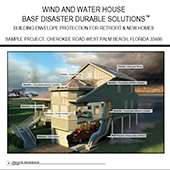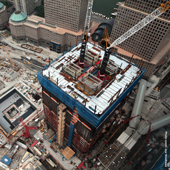Building for Disasters
Creating Disaster Durable Solutions™ is nothing new to us. We've developed many that go beyond the requirements of the insurance, energy and building industries.
Strong buildings need strong science.
Although we can't always predict the weather, with new technology in the building and construction industry, we can build (and retrofit) stronger and more storm-resistant homes, buildings and structures with disaster mitigation in mind.
That takes science and a holistic, systems-centric approach to construction. It takes smart design and skilful construction techniques.
Here’s a look at building for disasters.
Test Your Knowledge: High-Wind Resiliency
The Federal Alliance for Safe Homes (FLASH) brought together professionals from across the United States for a two-day charrette on best practices for building before and after high-wind disasters. Together, they developed a Resilient Design Guide — a collection of knowledge on the whys and hows of resilient wind construction.
Resilient Design Guide
You can download the guide here, but before you do, why not test your knowledge below:
Take the test
The roof component damaged most often in high wind is:
A: Roof covering (shingle, tile, etc.) B: Frame
Correct!
According to FEMA, the roof component damaged most often in high wind is the roof covering. The second most common component damaged? Sheathings.
No.
According to FEMA, the roof component damaged most often in high wind is the roof covering.
True or false: It’s a good idea to fasten underlayment materials (felt/tar paper) with staples as the shingles on top will secure the underlayment.
Correct!
In a high wind zone, roof shingles are often lost, taking with them the attached underlayment. This means no protection from water intrusion. Look to peel-and-stick membrane products for superior underlayment protection.
Incorrect.
In a high wind zone, roof shingles are often lost, taking with them the attached underlayment. This means no protection from water intrusion. Look to peel-and-stick membrane products for superior underlayment protection.
True or false: French double-doors are great at withstanding high-winds.
Correct!
Double doors often fail in high winds because they are weak where they come together, especially if they swing inward.
Incorrect.
Double doors often fail in high winds because they are weak where they come together, especially if they swing inward.
A
B
True
False
True
False
There’s a lot more great information in
the Resilient Design Guide.
Close-up: Building Envelope
A building is a system, much like a human body. All the parts must work together. For homes and buildings, designing seamless building envelopes with every element (roof, foundation and walls) securely attached to the next is key to disaster-resiliency. It also means no gaps or holes where wind or water can enter and cause damage.
Have a look at this sample project for an in-depth look at how the entire building envelope can protect against wind and water.
Download Sample Project Now
Case Study: Withstanding Sandy
Atlantis Hotel and Casino
After Category 5 Hurricane Floyd hit the Bahamas in September 1999 with punishing winds of 155 miles per hour (mph) the five-tower, 2,300-room Atlantis, Paradise Island hotel remained standing. The hotelcasino had been clad two years earlier with 425,000 square feet of BASF Wall Systems' Senergy exterior insulation and finish system (EIFS). To fabricate special design elements, the installers used BASF Wall Systems' Senerflex insulation board ranging from 0.75 to 14-inches thick.
After the hurricane, hotel officials said, "there was zero damage to the exterior, with minor damage to the roof and ornamentation. The exterior insulation performed as designed."
By using adhesive versus traditional mechanical means to attach the wall system, the structure was able to withstand wind speeds of more than 200 mph. Its continuous fiberglass reinforcing mesh, available in five weights, also protected walls against impact damage.
Product Focus: Closing the Gap
Another key element of building disaster resilient structures is ensuring that every gap in a building’s enclosure is closed.
Closed-cell, spray-applied polyurethane foam (ccSPF) materials expand to close every gap in the enclosure, providing almost-total air leakage control, as well as moisture-vapor transmission resistance, for a truly sustainable, higher-performing building envelope.
ELASTOSPRAY® roofing systems, WALLTITE® insulating air barrier materials for commercial construction, and SPRAYTITE® insulating air barrier materials for residential construction are a few products BASF offers. All have industry-leading air permeance ratings combined with superior R-values of R-6.7 per inch.
They even add to structural strength by increasing rack and shear, providing resistance to flood water for up to 72 hours, and, in the case of the roofing systems, offering the industry's highest wind uplift resistance.
Stronger than steel alone: Sandwich Plate System (SPS)
Canadian-based Intelligent Engineering Limited, along with BASF, has developed an advanced alternative to conventional stiffened steel plates. The patented Sandwich Plate System (SPS), which is created by injecting a two-part, thermosetting polyurethane elastomer between a steel deck construction, has revolutionized steel engineering.
SPS offers outstanding load capacity with shorter production times. In addition, SPS is 75% lighter, and 80% thinner than concrete in most applications.
Uses for SPS include: Blast walls Bridge decks – building, repair and rehabilitation Structural flooring Stadia and arena terraces
Watch How Sandwich Plate System (SPS) is Engineered to Reduce Structural Failure










